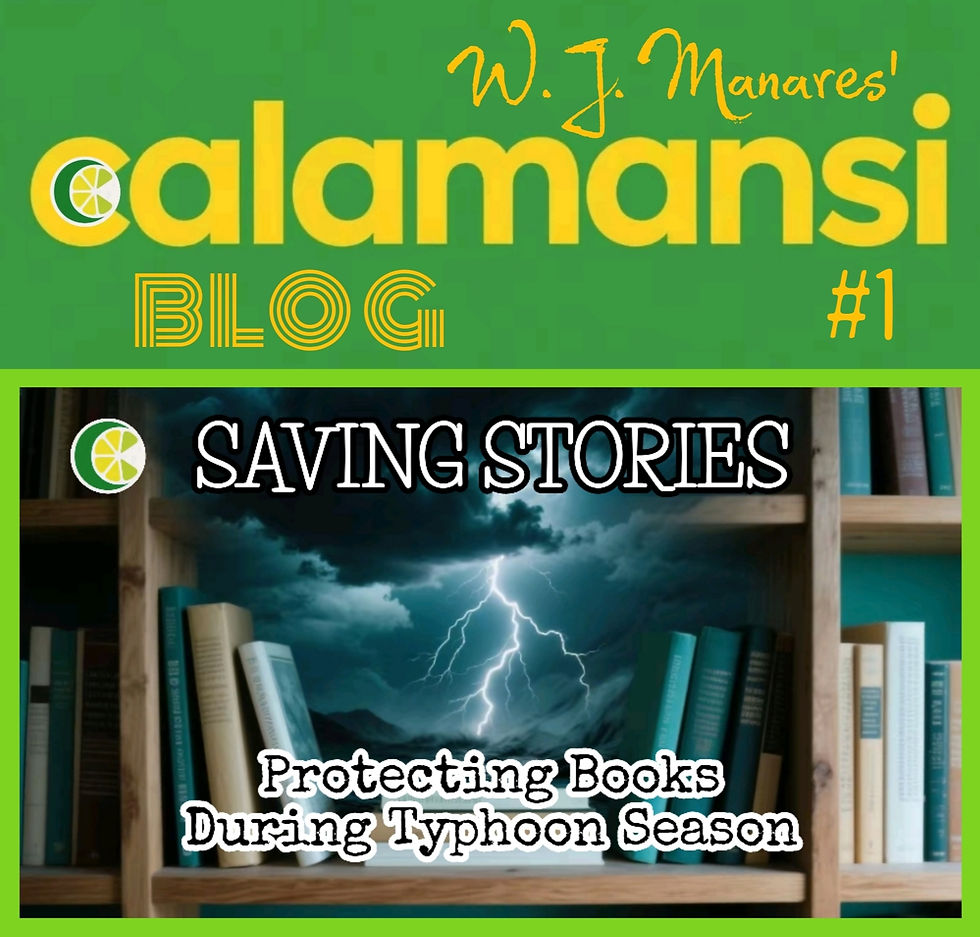CALAMANSI BLOG #1
- wjmanares
- Nov 9
- 3 min read
Updated: Nov 14

SAVING STORIES: Protecting Books During Typhoon Season
by W. J. Manares
Typhoon season in the Philippines means heavy rains, strong winds, and potential flooding. For book lovers, this can be a stressful time, as our beloved books are vulnerable to water damage and mold. But don't worry, with a few simple precautions, you can keep your literary treasures safe!
Before the Storm
1. Elevate, Elevate, Elevate
The most important thing is to keep your books off the floor. Water rises quickly, so move your bookshelves to higher ground if possible. If not, place your books on sturdy tables, shelves, or even pallets.
2. Seal the Deal
Plastic is your friend! Wrap your bookshelves or individual books in plastic sheeting or large garbage bags. This creates a barrier against moisture. For extra protection, consider using waterproof containers.
3. Back Away From the Walls
Move your bookshelves away from exterior walls, as these are more prone to leaks. Give them a few inches of space to allow for air circulation.
4. Inventory is Key
Take photos of your bookshelves and document your collection. This will be helpful if the worst happens.
During and After the Storm
1. Stay Vigilant
Keep an eye on water levels and check for leaks. If water starts to seep in, try to move your books to a safer location.
2. Dry 'Em Out
If your books do get wet, act fast! Gently blot away excess water with clean towels. Don't rub!
3. Air it Out
Place the books in a well-ventilated area with good airflow. You can use a fan to speed up the drying process. Avoid direct sunlight, as this can damage the pages.
4. Mold Patrol
Keep an eye out for mold. If you spot any, gently wipe it away with a soft cloth dampened with rubbing alcohol.
Typhoons are a part of life in the Philippines, but with a little preparation, you can protect your precious books and keep the stories alive for years to come. Stay safe and happy reading!
***
NOTE:
Why "Calamansi" Blog?
I chose the name 'Calamansi Blog' because it embodies the essence of what I want my blog to be. The calamansi, that small but vibrant Philippine lime, symbolizes joy and freshness. Just as the fruit adds a burst of flavor to any dish or drink, I want my blog to bring a fresh and uplifting perspective to the readers.
Beyond its Filipino roots, the name also resonates with me on a deeper level. 'Calamansi' bears a phonetic resemblance to the Indian words 'Kalam' (कलम), meaning 'pen' or 'writing,' and 'Anshi' (अंशी), meaning 'god's gift.' This connection suggests that my writing is more than just words on a page; it's a gift, an inspiration, perhaps even divinely guided.
My 'Calamansi Blog' represents a blend of Filipino zest and a sense of inspired creativity. It's a name that is both memorable and meaningful, reflecting my commitment to sharing content that is joyful, refreshing, and purposeful.
***
W. J. Manares is the Partner/Distributor of Ukiyoto Publishing via Ukiyoto House, Philippines. He's one of Ukiyoto's prolific authors and a one-of-a-kind writer from Aklan, Philippines, authored more than 69 books and counting, a lesser-known worldbuilder and storyteller, and labelled as "the sardonic yet whimsical author of the Philippines" since 1999. You can contact him via email: wjmanares@ukiyoto.com or via SMS at +639192015217.
LIKE and FOLLOW on Facebook:




Comments